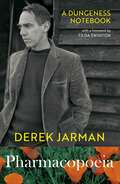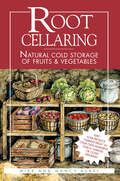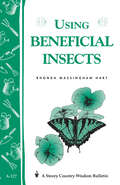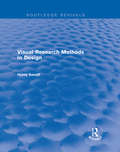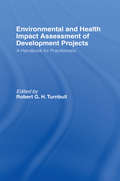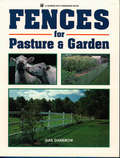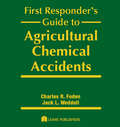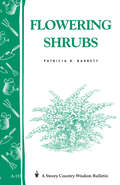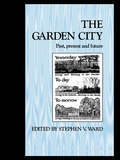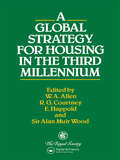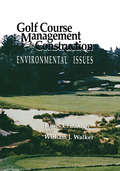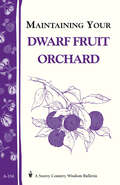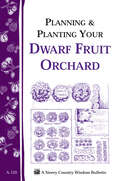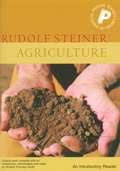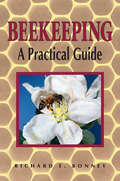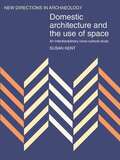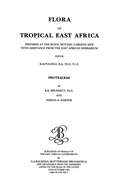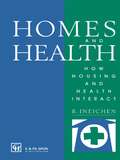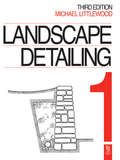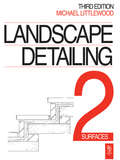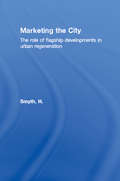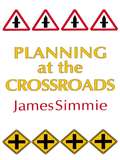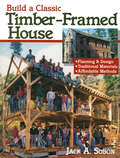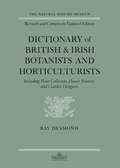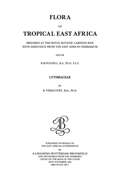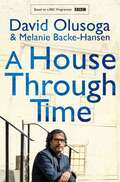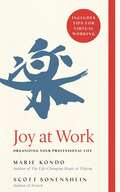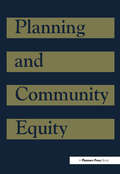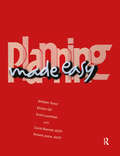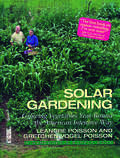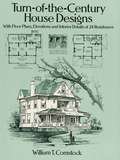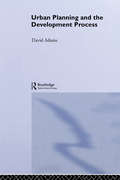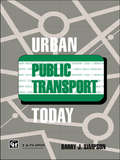Pharmacopoeia: A Dungeness Notebook
by Derek Jarman'I planted a dog rose. Then I found a curious piece of driftwood and used this, and one of the necklaces of holey stones on the wall, to stake the rose. The garden had begun. I saw it as a therapy and a pharmacopoeia.' In 1986 artist and filmmaker, Derek Jarman, bought Prospect Cottage, a Victorian fisherman's hut on the desert sands of Dungeness. It was to be a home and refuge for Jarman throughout his HIV diagnosis, and it would provide the stage for one of his most enduring, if transitory projects - his garden. Conceived of as a 'pharmacopoeia' - an ever-evolving circle of stones, plants and flotsam sculptures all built and grown in spite of the bracing winds and arid shingle - it remains today a site of fascination and wonder.Pharmacopoeia brings together the best of Derek Jarman's writing on nature, gardening and Prospect Cottage. Told through journal entries, poems and fragments of prose, it paints a portrait of Jarman's personal and artistic reliance on the space Dungeness offered him, and shows the cycle of the years spent there in one moving collage.'[Derek] made of this wee house, his wooden tent pitched in the wilderness, an artwork - and out of its shingle skirts, an ingenious garden - now internationally recognised. But, first and foremost, the cottage was always a living thing, a practical toolbox for his work' Tilda Swinton, from her Foreword
Root Cellaring: Natural Cold Storage of Fruits & Vegetables
by Mike Bubel Nancy BubelDiscover how easy it can be to turn some extra space in your basement, garage, or even your closet into your very own root cellar.
Using Beneficial Insects: Storey's Country Wisdom Bulletin A-127 (Storey Country Wisdom Bulletin)
by Rhonda Massingham HartSince 1973, Storey's Country Wisdom Bulletins have offered practical, hands-on instructions designed to help readers master dozens of country living skills quickly and easily. There are now more than 170 titles in this series, and their remarkable popularity reflects the common desire of country and city dwellers alike to cultivate personal independence in everyday life.
Visual Research Methods in Design (Routledge Revivals)
by Henry SanoffFirst published in 1991, this book is about applications and issues relating to the visual environment. The content pertains to the understanding of human behaviour in the environment by recording behaviour and actions or by direct interaction with people. The author examines research and planning methods that primarily stress the visual features of the physical environment. Traditionally, environmental research has relied on verbal descriptions and perceptions of the physical environment, virtually ignoring the visual component and the potential application of the social sciences for gathering this data. Various strategies that can expand the visual information base have been explored here: diagramming, photo-interviewing, photo-sorting, mapping, notation, simulation, videotaping, and CADD.
Visual Research Methods in Design (Routledge Revivals)
by Henry SanoffFirst published in 1991, this book is about applications and issues relating to the visual environment. The content pertains to the understanding of human behaviour in the environment by recording behaviour and actions or by direct interaction with people. The author examines research and planning methods that primarily stress the visual features of the physical environment. Traditionally, environmental research has relied on verbal descriptions and perceptions of the physical environment, virtually ignoring the visual component and the potential application of the social sciences for gathering this data. Various strategies that can expand the visual information base have been explored here: diagramming, photo-interviewing, photo-sorting, mapping, notation, simulation, videotaping, and CADD.
Environmental and Health Impact Assessment of Development Projects: A handbook for practitioners
by The World Health OrganizationThis handbook for practitioners in environmental and public health, environmental management, toxicology and ecotoxicology has been prepared by an international group of experts from both developing and developed countries and covers a wide range of topics in both environmental impact assessment and environmental health impact assessment.
Environmental and Health Impact Assessment of Development Projects: A handbook for practitioners
by The World Health OrganizationThis handbook for practitioners in environmental and public health, environmental management, toxicology and ecotoxicology has been prepared by an international group of experts from both developing and developed countries and covers a wide range of topics in both environmental impact assessment and environmental health impact assessment.
Fences for Pasture & Garden
by Gail DamerowWhether you&’re trying to protect your garden from wildlife predators or want to keep your livestock from wandering too far, effective fencing can bring welcome peace of mind. Covering the pros and cons of a variety of fencing types, Gail Damerow shows you how to build a fence that works for your needs. With clearly illustrated instructions for building wire fences, rail fences, electric fences, woven fences, and more, you&’ll soon be creating effective enclosures that are guaranteed to save you time, money, and worry.
First Responder's Guide to Agricultural Chemical Accidents
by Charles R. Foden Jack L. WeddellFirst Responder's Guide to Agricultural Chemical Accidents provides emergency safety and health information for 452 toxic and hazardous products. These products, frequently used by pest exterminators and farmers, include those insecticides, pesticides, rodenticides, herbicides, and fertilizers commonly transported on highways and by rail carriers. The book lists products alphabetically and includes the manufacturer and telephone number, chemical identification, physical properties, hazard ratings, neutralizing agents (when known), fire fighting agents, special warnings, evacuation distances, protective clothing, health hazard information, and emergency first aid for exposure. This important information allows any First Responder to establish a safe plan of action without having to reference the library of chemical books normally carried by a Hazardous Materials Emergency Response Team (HERT).First Responder's Guide to Agricultural Chemical Accidents is an essential reference that provides critical hazardous materials data for personnel at fire departments, law enforcement agencies, and emergency medical agencies. The book will also be useful for business or individuals that store, sell, or use agricultural chemicals.
First Responder's Guide to Agricultural Chemical Accidents
by Charles R. Foden Jack L. WeddellFirst Responder's Guide to Agricultural Chemical Accidents provides emergency safety and health information for 452 toxic and hazardous products. These products, frequently used by pest exterminators and farmers, include those insecticides, pesticides, rodenticides, herbicides, and fertilizers commonly transported on highways and by rail carriers. The book lists products alphabetically and includes the manufacturer and telephone number, chemical identification, physical properties, hazard ratings, neutralizing agents (when known), fire fighting agents, special warnings, evacuation distances, protective clothing, health hazard information, and emergency first aid for exposure. This important information allows any First Responder to establish a safe plan of action without having to reference the library of chemical books normally carried by a Hazardous Materials Emergency Response Team (HERT).First Responder's Guide to Agricultural Chemical Accidents is an essential reference that provides critical hazardous materials data for personnel at fire departments, law enforcement agencies, and emergency medical agencies. The book will also be useful for business or individuals that store, sell, or use agricultural chemicals.
Flowering Shrubs: Storey's Country Wisdom Bulletin A-132 (Storey Country Wisdom Bulletin)
by Patricia R. BarrettSince 1973, Storey's Country Wisdom Bulletins have offered practical, hands-on instructions designed to help readers master dozens of country living skills quickly and easily. There are now more than 170 titles in this series, and their remarkable popularity reflects the common desire of country and city dwellers alike to cultivate personal independence in everyday life.
The Garden City: Past, present and future (Planning, History and Environment Series)
by Stephen WardThis examination of a phenomenon of 19th century planning traces the origins, implementation, international transference and adoption of the Garden City idea. It also considers its continuing relevance in the late 20th century and into the 21st century.
A Global Strategy for Housing in the Third Millennium (Technology In The Third Millennium Ser.)
by W. A. Allen R. G. Courtney E. Happold Alan Muir WoodThis book outlines the emerging determinants, in a global context, for the provision of housing for the growing, shifting and changing populations. In doing so the reader will be encouraged to forsee the complementary evolution in the planning, design and construction of housing in the developed and developing world.
A Global Strategy for Housing in the Third Millennium
by W. A. Allen R. G. Courtney E. Happold A. M. WoodThis book outlines the emerging determinants, in a global context, for the provision of housing for the growing, shifting and changing populations. In doing so the reader will be encouraged to forsee the complementary evolution in the planning, design and construction of housing in the developed and developing world.
Golf Course Management & Construction: Environmental Issues
by James C. Balogh William J. WalkerGolf Course Management & Construction presents a comprehensive summary and assessment of technical and scientific research on the environmental effects of turfgrass system construction and maintenance. Although the book focuses on golf courses, it also discusses turfgrass systems for residential and commercial lawns, parks, and greenways. The book is an excellent introduction to the concepts of nonpoint source environmental impacts of turfgrass management for turfgrass scientists and specialists, landscape and golf course architects, turfgrass system and golf course developers, golf course superintendents, environmental scientists, and land-use regulators.
Golf Course Management & Construction: Environmental Issues
by James C. Balogh William J. WalkerGolf Course Management & Construction presents a comprehensive summary and assessment of technical and scientific research on the environmental effects of turfgrass system construction and maintenance. Although the book focuses on golf courses, it also discusses turfgrass systems for residential and commercial lawns, parks, and greenways. The book is an excellent introduction to the concepts of nonpoint source environmental impacts of turfgrass management for turfgrass scientists and specialists, landscape and golf course architects, turfgrass system and golf course developers, golf course superintendents, environmental scientists, and land-use regulators.
Maintaining Your Dwarf Fruit Orchard: Storey's Country Wisdom Bulletin A-134 (Storey Country Wisdom Bulletin)
by Editors of Storey PublishingSince 1973, Storey's Country Wisdom Bulletins have offered practical, hands-on instructions designed to help readers master dozens of country living skills quickly and easily. There are now more than 170 titles in this series, and their remarkable popularity reflects the common desire of country and city dwellers alike to cultivate personal independence in everyday life.
Planning & Planting Your Dwarf Fruit Orchard: Storey's Country Wisdom Bulletin A-133 (Storey Country Wisdom Bulletin)
by Editors of Garden Way PublishingSince 1973, Storey's Country Wisdom Bulletins have offered practical, hands-on instructions designed to help readers master dozens of country living skills quickly and easily. There are now more than 170 titles in this series, and their remarkable popularity reflects the common desire of country and city dwellers alike to cultivate personal independence in everyday life.
Agriculture: An Introductory Reader (Pocket Library Of Spiritual Wisdom)
by Rudolf SteinerRudolf Steiner, the often undervalued, multifaceted genius of modern times, contributed much to the regeneration of culture. In addition to his philosophical teachings, he provided ideas for the development of many practical activities, including education - both general and special - agriculture, medicine, economics, architecture, science, religion and the arts. Today there are thousands of schools, clinics, farms, and many other organizations that are founded directly on his principles.
Beekeeping: A Practical Guide
by Richard E. BonneyKeep your own bees and enjoy delicious golden honey from your own backyard. With his respect and admiration for bees evident on every page, Richard E. Bonney describes how to acquire bees, manage a hive, prevent and treat diseases, and extract a crop of honey. Enthusiastic beekeepers of every stripe and experience level will benefit from Bonney&’s astonishing knowledge of the craft — from beekeeping history and honeybee biology to the complex social structure of the hive.
Domestic Architecture And The Use Of Space: An Interdisciplinary Cross-cultural Study (New Directions In Archaeology Ser.)
by Susan Kent Norman Yoffee Wendy Ashmore Francoise Audouze Cyprian Broodbank Tim Murray Colin Renfrew Nathan Schlanger Andrew Sherratt Timothy TaylorFlora of Tropical East Africa - Proteaceae (1993)
by R. K. Brummitt Serena K. MarnerPart of a series on the flora of tropical East Africa, this work considers Proteaceae. The flora is prepared at Royal Botanic Gardens, Kew in close collaboration with East African Herbarium and in liaison with the University of Dar es Salaam, the University of Nairobi and the Makerere University. Significant contributions are also made by specialists from elsewhere. The flora should be a useful reference for anyone concerned with the identification and utilization of plants in eastern Africa. Each family is published as a separate part. New parts are published annually. All back volumes are also available.
Flora of Tropical East Africa - Proteaceae (1993)
by R. K. Brummitt Serena K. MarnerPart of a series on the flora of tropical East Africa, this work considers Proteaceae. The flora is prepared at Royal Botanic Gardens, Kew in close collaboration with East African Herbarium and in liaison with the University of Dar es Salaam, the University of Nairobi and the Makerere University. Significant contributions are also made by specialists from elsewhere. The flora should be a useful reference for anyone concerned with the identification and utilization of plants in eastern Africa. Each family is published as a separate part. New parts are published annually. All back volumes are also available.
Homes and Health: How Housing and Health Interact
by Bernard IneichenThis book links where people live with their health. The author reviews how housing has influenced health throughout the past hundred and fifty years, discusses in detail current issues concerning housing and health and describes attempts at housing particular groups whose health is at risk.
Homes and Health: How Housing and Health Interact
by Bernard IneichenThis book links where people live with their health. The author reviews how housing has influenced health throughout the past hundred and fifty years, discusses in detail current issues concerning housing and health and describes attempts at housing particular groups whose health is at risk.
Landscape Detailing Volume 1
by Michael LittlewoodMichael Littlewood's Landscape Detailing is now well established as a valuable source of reference for architects, landscape architects, other professionals and students designing external works.Volume I, Enclosures, covers walls (free-standing, screen and retaining), fences, gates, barriers and bollards. Each section begins with technical guidance notes on design and construction and then provides a list of points against which specifications can be checked. This is followed by a set of drawn-to-scale detail sheets. These details can be traced for direct incorporation into the set of contract drawings. A list of relevant British Standards, references, bibliography and a list of associations and institutions indicate where further guidance can be obtained. As a ready reference for landscape designers and as an indispensable time-saving tool, Landscape Detailing is an essential for the design office.
Landscape Detailing Volume 1: Enclosures
by Michael LittlewoodMichael Littlewood's Landscape Detailing is now well established as a valuable source of reference for architects, landscape architects, other professionals and students designing external works.Volume I, Enclosures, covers walls (free-standing, screen and retaining), fences, gates, barriers and bollards. Each section begins with technical guidance notes on design and construction and then provides a list of points against which specifications can be checked. This is followed by a set of drawn-to-scale detail sheets. These details can be traced for direct incorporation into the set of contract drawings. A list of relevant British Standards, references, bibliography and a list of associations and institutions indicate where further guidance can be obtained. As a ready reference for landscape designers and as an indispensable time-saving tool, Landscape Detailing is an essential for the design office.
Landscape Detailing Volume 2: Surfaces
by Michael LittlewoodAs a ready reference for landscape designers and as an indispensable time-saving tool, Landscape Detailing is an essential for the design office.Each section begins with technical guidance notes on design and construction and then provides a list of points against which specifications can be checked. This is followed by a set of drawn-to-scale details sheets. These details can be traced for direct incorporation into the set of contract drawings. A list of relevant British Standards, references, bibliography and a list of associations and institutions indicate where further guidance can be obtained.
Landscape Detailing Volume 2
by Michael LittlewoodAs a ready reference for landscape designers and as an indispensable time-saving tool, Landscape Detailing is an essential for the design office.Each section begins with technical guidance notes on design and construction and then provides a list of points against which specifications can be checked. This is followed by a set of drawn-to-scale details sheets. These details can be traced for direct incorporation into the set of contract drawings. A list of relevant British Standards, references, bibliography and a list of associations and institutions indicate where further guidance can be obtained.
Marketing the City: The role of flagship developments in urban regeneration
by H. SmythThis book assesses the value of flagship developments and draws out lessons for best policy and practice. It looks at marketing strategies and the sales process for flagship developments and the areas in which they are located for urban regeneration. It discusses the management of marketing strategies and the development through the policy formulation, project implementation and policy/project evaluation. The author examines the strategies to date of 'marketing the city' and the conceptual scope and limits for developing the concept. He also looks at the extent to which people can be integrated into the urban 'product' and the advantages and disadvantages of this. Finally the impact of all these issues is assessed for the policy makers, planners, developers, architects and city authorities.
Marketing the City: The role of flagship developments in urban regeneration
by H. SmythThis book assesses the value of flagship developments and draws out lessons for best policy and practice. It looks at marketing strategies and the sales process for flagship developments and the areas in which they are located for urban regeneration. It discusses the management of marketing strategies and the development through the policy formulation, project implementation and policy/project evaluation. The author examines the strategies to date of 'marketing the city' and the conceptual scope and limits for developing the concept. He also looks at the extent to which people can be integrated into the urban 'product' and the advantages and disadvantages of this. Finally the impact of all these issues is assessed for the policy makers, planners, developers, architects and city authorities.
Planning At The Crossroads
by James SimmieThrough a detailed analysis of studies of the effects of planning, comparing low levels of urban containment in California with much higher levels in the UK. Some comparative insights are also drawn from the (pre-conflict) Yugoslavian planning system. The analysis shows that many of the serious criticisms of planning are valid and leads to the conclusion that some sacred cows - notably "green belts" - should be abandoned. This distinctive text is of use to students, researchers and professionals in planning, geography and urban studies.
Planning At The Crossroads
by James SimmieThrough a detailed analysis of studies of the effects of planning, comparing low levels of urban containment in California with much higher levels in the UK. Some comparative insights are also drawn from the (pre-conflict) Yugoslavian planning system. The analysis shows that many of the serious criticisms of planning are valid and leads to the conclusion that some sacred cows - notably "green belts" - should be abandoned. This distinctive text is of use to students, researchers and professionals in planning, geography and urban studies.
Build a Classic Timber-Framed House: Planning & Design/Traditional Materials/Affordable Methods
by Jack A. SobonBuild a classic, enduring, and affordable home. With Jack A. Sobon&’s careful guidance, you can construct your own timber-framed house in the traditional hall-and-parlor style. From felling trees to cutting timbers, and frame construction to door selection, you&’ll find Sobon&’s professional advice and hand-drawn illustrations invaluable. Whether you&’re a first-time builder or a seasoned contractor looking to expand your repertoire, you&’ll find answers to all your timber-frame questions. Open the front door and walk into the home of your dreams.
Dictionary Of British And Irish Botantists And Horticulturalists Including plant collectors, flower painters and garden designers
by Ray DesmondOver the past four centuries botanists and gardeners in the British Isles have gathered, maintained and propagated many varying species of plants. Their work has been documented in innumerable books and articles which are often difficult to trace. The Dictionary of British and Irish Botanists and Horticulturalists represents a time-saving reference source for those who wish to discover more about the lives and achievements of the horticulturalists listed. The dictionary's utility comes not only from indicating the major publications of the named authors, but also the location of their herbaria and manuscripts.; The previous 1977 edition of the Dictionary has for many years been a much used source of information for botanists, botanic artists and archivists. In this revised edition the scope has been expanded to include among its 13,000 entries flower painters in addition to botanical artists over 1400 entries and, for the first time, garden designers.; Finally the Dictionary should have international appeal since so many botanists and gardeners worked on collective plants overseas, in particular in North America and the British Commonwealth.; Each entry gives, wherever possible, details of dates and places of birth and death, educational qualifications, professional posts, honours and awards, publications, location of plant collections, manuscripts, drawings and portraits. Its main function, however, is to provide further biographical references to books and periodicals. Comprehensive classified indices facilitate access by professions and activities, countries, and plant interests.
Dictionary Of British And Irish Botantists And Horticulturalists Including plant collectors, flower painters and garden designers
by Ray DesmondOver the past four centuries botanists and gardeners in the British Isles have gathered, maintained and propagated many varying species of plants. Their work has been documented in innumerable books and articles which are often difficult to trace. The Dictionary of British and Irish Botanists and Horticulturalists represents a time-saving reference source for those who wish to discover more about the lives and achievements of the horticulturalists listed. The dictionary's utility comes not only from indicating the major publications of the named authors, but also the location of their herbaria and manuscripts.; The previous 1977 edition of the Dictionary has for many years been a much used source of information for botanists, botanic artists and archivists. In this revised edition the scope has been expanded to include among its 13,000 entries flower painters in addition to botanical artists over 1400 entries and, for the first time, garden designers.; Finally the Dictionary should have international appeal since so many botanists and gardeners worked on collective plants overseas, in particular in North America and the British Commonwealth.; Each entry gives, wherever possible, details of dates and places of birth and death, educational qualifications, professional posts, honours and awards, publications, location of plant collections, manuscripts, drawings and portraits. Its main function, however, is to provide further biographical references to books and periodicals. Comprehensive classified indices facilitate access by professions and activities, countries, and plant interests.
Flora of Tropical East Africa - Lythraceae (1994)
by B. VerdcourtThis book is a comprehensive review of the genera of Lythraceae, a flowering plant family of mostly trees and shrubs, found in tropical East Africa. It presents information on their character, occurrence, habitat, phenotypic variations and distribution of each of the species under these genera.
Flora of Tropical East Africa - Lythraceae (1994)
by B. VerdcourtThis book is a comprehensive review of the genera of Lythraceae, a flowering plant family of mostly trees and shrubs, found in tropical East Africa. It presents information on their character, occurrence, habitat, phenotypic variations and distribution of each of the species under these genera.
A House Through Time: Tv Tie-in
by David OlusogaIn recent years house histories have become the new frontier of popular, participatory history. People, many of whom have already embarked upon that great adventure of genealogical research, and who have encountered their ancestors in the archives and uncovered family secrets, are now turning to the secrets contained within the four walls of their homes and in doing so finding a direct link to earlier generations. And it is ordinary homes, not grand public buildings or the mansions of the rich that have all the best stories.As with the television series, A House Through Time offers readers not only the tools to explore the histories of their own homes, but also a vividly readable history of the British city, the forces of industry, disease, mass transportation, crime and class. The rises and falls, the shifts in the fortunes of neighbourhoods and whole cities are here, tracing the often surprising journey one single house can take from elegant dwelling in a fashionable district to a tenement for society’s rejects.Packed with remarkable human stories, it is a phenomenal insight into living history, a history we can see every day on the streets where we live. And it reminds us that it is at home that we are truly ourselves. It is there that the honest face of life can be seen. At home, behind closed doors and drawn curtains, we live out our inner lives and family lives.
Joy at Work: Organizing Your Professional Life
by Marie Kondo Scott SonensheinIf you properly simplify and organize your work life once, you’ll never have to do it again. Marie Kondo's first book, The Life-Changing Magic of Tidying, sparked a new genre of publishing and became an international bestseller. Now, for the first time, you will be guided through the process of tidying up your work life.In Joy at Work, KonMari method pioneer Marie Kondo and organizational psychologist Scott Sonenshein will help you to refocus your mind on what's important at work, and as their examples show, the results can be truly life-changing. With advice on how to improve the way you work, the book features advice on problem areas including fundamentals like how to organize your desk, finally get through your emails and find what sparks joy in an open plan office. Like how the key to successful tidying in the home is by tackling clutter in the correct order, Joy at Work adapts the inspirational KonMari Method for the workplace, taking you step-by-step through your professional environment so that you can identify the most joyful way to work for you. Once you’ve found order in your work life, you can feel empowered to find confidence, energy and motivation to create the career you want and move on from negative working practices.
Planning and Community Equity: A Component of APA's Agenda for America's Communities
by American Institute of Certified PlannersThis thought-provoking book exhorts planners to establish community development programs that achieve greater social and economic equity. Some of the 13 chapters urge planners to incorporate community equity concerns into traditional planning areas such as transportation and economic development. Others challenge planners to get more involved in social areas such as urban education and community policing. Each chapter is authored by one or more professionals with expertise in the subject at hand. A helpful resource for planners who continue to tackle the problems of inequality.
Planning and Community Equity: A Component of APA's Agenda for America's Communities
by American Institute of Certified PlannersThis thought-provoking book exhorts planners to establish community development programs that achieve greater social and economic equity. Some of the 13 chapters urge planners to incorporate community equity concerns into traditional planning areas such as transportation and economic development. Others challenge planners to get more involved in social areas such as urban education and community policing. Each chapter is authored by one or more professionals with expertise in the subject at hand. A helpful resource for planners who continue to tackle the problems of inequality.
Planning Made Easy
by William Toner Efraim Gil Enid Lucchesi Carol Barrett Robert JoiceDeveloping a program to train planning commissioners and zoning board members takes a lot of time and effort. This manual makes the process easier. It covers the basics of community planning, zoning, subdivision regulation, and ethics. With chapters organized in discrete modules, it's ideal for both self-study and classroom use. Narratives explain general planning principles. Exercises encourage users to think about the planning issues in their communities. And worksheets reinforce important concepts. A complementary training guide, Training Made Easy, is also available. Planning Made Easy is published as looseleaf pages in a three-ring notebook.
Planning Made Easy
by William Toner Efraim Gil Enid Lucchesi Carol Barrett Robert JoiceDeveloping a program to train planning commissioners and zoning board members takes a lot of time and effort. This manual makes the process easier. It covers the basics of community planning, zoning, subdivision regulation, and ethics. With chapters organized in discrete modules, it's ideal for both self-study and classroom use. Narratives explain general planning principles. Exercises encourage users to think about the planning issues in their communities. And worksheets reinforce important concepts. A complementary training guide, Training Made Easy, is also available. Planning Made Easy is published as looseleaf pages in a three-ring notebook.
Solar Gardening: Growing Vegetables Year-Round the American Intensive Way (Real Goods Independent Living Bks.a\real Goods Independent Living Book)
by Leandre Poisson Gretchen Vogel Poisson Robin WimbiscusSolar Gardening shows how to increase efforts of the sun during the coldest months of the year and how to protect tender plants from the intensity of the scorching sun during the hottest months through the use of solar "mini-greenhouses." The book includes instructions for building a variety of solar appliances plus descriptions of more than 90 different crops, with charts showing when to plant and harvest each. The result is a year-round harvest even from a small garden. In Solar Gardening the Poissons show you how to: Dramatically increase the annual square-foot yield of your garden. Extend the growing and harvest season for nearly every kind of vegetable. Select crops that will thrive in the coldest and hottest months of the year, without artificial heating or cooling systems. Build solar appliances for your own garden. Armed with nothing but this book and a few simple tools, even novice gardeners can quickly learn to extend their growing season and increase their yields, without increasing the size of their garden plot.
Turn-of-the-Century House Designs: With Floor Plans, Elevations and Interior Details of 24 Residences
by William T. ComstockThis inexpensive archive of handsome turn-of-the-century designs reprinted directly from a rare late Victorian volume contains plans for a variety of suburban and country homes that are both aesthetically appealing and moderate in cost. Included are plans for 24 cottages and houses in a wide range of styles, among them Queen Anne, Eastlake, and Colonial. Over 130 illustrations — floor plans, elevations, perspective views, and more — enhance the text, which is further supplemented by two informative and useful articles: "Suggestions on House Building," by A. W. Cobb, describes the process of building a home, from the first sketches offered by the architect to his client, to property selection, scale drawings, and details of construction. “How to Plumb a Suburban House,” by Leonard D. Hosford, provided the late Victorian era homeowner with valuable advice about sewage disposal.Restorers of old houses, preservationists, and students of American architectural history will welcome this treasury of authentic century-old plans and details. Students of social history will also find it an excellent reference.
Urban Planning And The Development Process
by David AdamsThis text is about the very essence of urban planning in a market economy. It is concerned with people - landowners, developers, investors, politicians and ordinary members of the public - who produce change in towns and cities as they relate to each other and react to development Pressure. Whether Such Change Occurs Slowly And Is Almost Unnoticed, Or happens rapidly and is highly disruptive, a production process is creating a finished product: the built environment. This form of production, known as the land and property development process, is regulated but not controlled by the state. Urban planning is therefore best considered as one form of state intervention in the development process.; Since urban planning would have no legitimate basis without state power, it is an inherently political activity, able to alter the distribution of scarce environmental resources. Through doing so, it seeks to resolve conflicts of interest over the use and development of land. However, urban plans that appear to favour particular interests such as house-builders above others such as community groups provoke intense controversy. Development planning can thus become highly politicized, with alliances and divisions between politicians not always explained by traditional party politics.; These issues are explored with particular reference to statutory plan-making at the local level. The author draws on his extensive research into urban planning and development, making use of recent case studies and examples to illustrate key points. There are four parts. The first explores the operation of land and property markets and development processes, and examines how the state intervenes in the form of urban planning. The second part looks at the people and organizations who play a critical role in shaping the built environment and considers their relationship with the planning system. Specific attention is paid to important actors in the development process, such as landowners, developers, financial institutions, professional advisers and to the variety of agencies in the public sector that aim to promote development. This concludes with discussion of public- private partnerships and growth coalitions. The third part of the book concentrates on local development planning.
Urban Planning And The Development Process
by David AdamsThis text is about the very essence of urban planning in a market economy. It is concerned with people - landowners, developers, investors, politicians and ordinary members of the public - who produce change in towns and cities as they relate to each other and react to development Pressure. Whether Such Change Occurs Slowly And Is Almost Unnoticed, Or happens rapidly and is highly disruptive, a production process is creating a finished product: the built environment. This form of production, known as the land and property development process, is regulated but not controlled by the state. Urban planning is therefore best considered as one form of state intervention in the development process.; Since urban planning would have no legitimate basis without state power, it is an inherently political activity, able to alter the distribution of scarce environmental resources. Through doing so, it seeks to resolve conflicts of interest over the use and development of land. However, urban plans that appear to favour particular interests such as house-builders above others such as community groups provoke intense controversy. Development planning can thus become highly politicized, with alliances and divisions between politicians not always explained by traditional party politics.; These issues are explored with particular reference to statutory plan-making at the local level. The author draws on his extensive research into urban planning and development, making use of recent case studies and examples to illustrate key points. There are four parts. The first explores the operation of land and property markets and development processes, and examines how the state intervenes in the form of urban planning. The second part looks at the people and organizations who play a critical role in shaping the built environment and considers their relationship with the planning system. Specific attention is paid to important actors in the development process, such as landowners, developers, financial institutions, professional advisers and to the variety of agencies in the public sector that aim to promote development. This concludes with discussion of public- private partnerships and growth coalitions. The third part of the book concentrates on local development planning.
Urban Public Transport Today
by Dr Barry Simpson B. SimpsonThis book is about how local public transport can be made a less unacceptable alternative to the private car than it is now. It is intended for officials, politicians and others interested in the land use/local transport conundrum. It is also valuable to town planners, those working for passenger transport authorities and anyone concerned with policy making and project appraisal for local public transport.
Urban Public Transport Today
by Dr Barry Simpson B. SimpsonThis book is about how local public transport can be made a less unacceptable alternative to the private car than it is now. It is intended for officials, politicians and others interested in the land use/local transport conundrum. It is also valuable to town planners, those working for passenger transport authorities and anyone concerned with policy making and project appraisal for local public transport.
